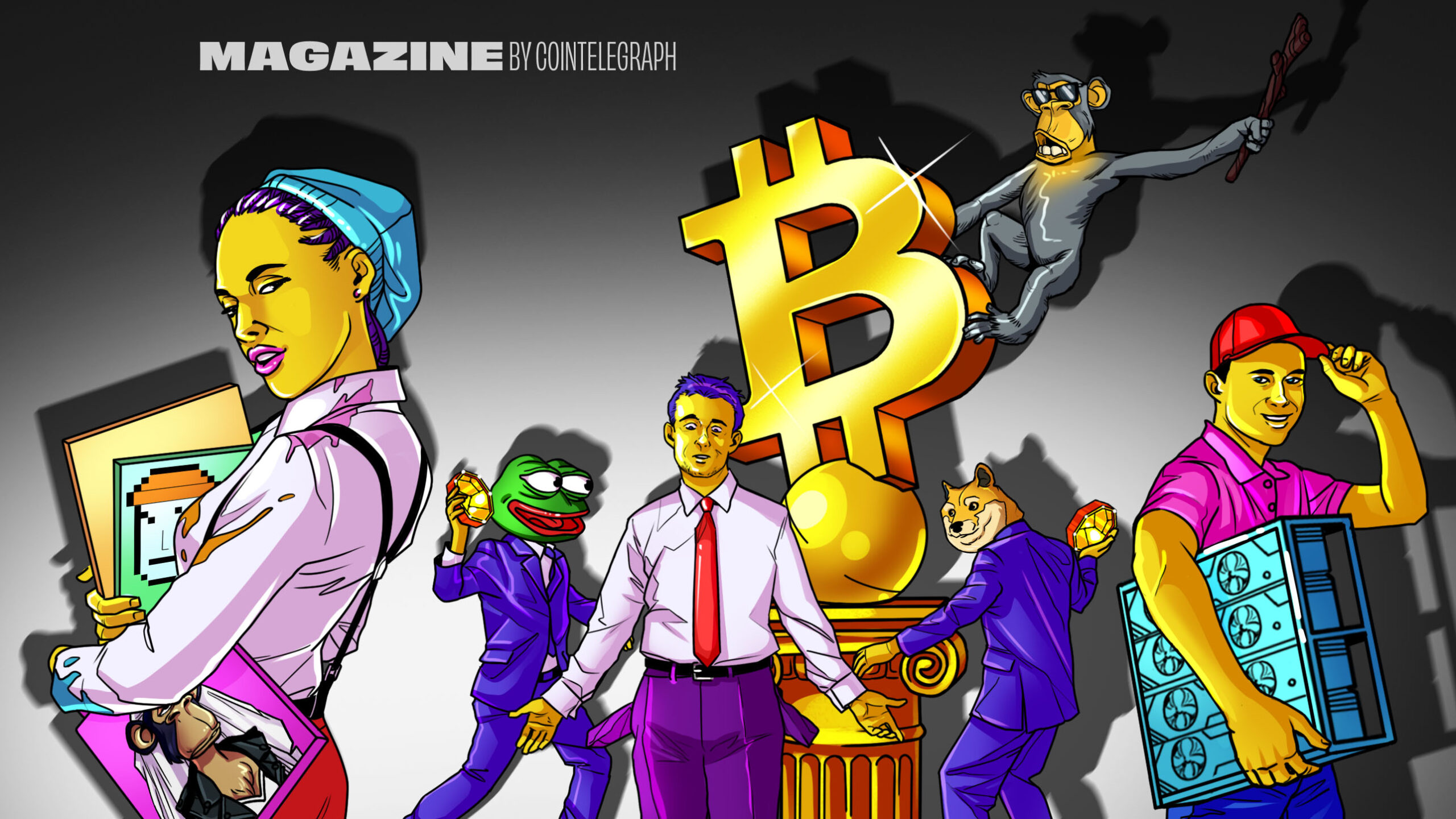The launch of BRC-20 tokens and Ordinals NFTs on Bitcoin has reworked the No. 1 blockchain in a single day right into a clunkier model of Ethereum.
The core builders and miners who signed off on the community’s Taproot improve in November 2021 by no means envisaged this might be the consequence. Bitcoin now suffers from lots of the identical issues which have bedeviled Ethereum for years, together with scammy memecoins and shitcoins, NFTs of monkey photos hogging block house and skyrocketing transaction charges.
The community is even having to cope with incidences of miner extractable worth (MEV), whereby miners revenue by reordering pending transactions.

“I’m type of upset at myself for not realizing,” says Quantum Economics founder Mati Greenspan, a Bitcoiner since 2013.
“It took these guys beginning to hype up JPEGs on Bitcoin till I used to be like: ‘Oh shit, what did we simply do?’” He laughs ruefully.
Some Bitcoiners on Bitcointalk and Twitter check with the influence of Ordinal NFTs and BRC-20 tokens as an assault on Bitcoin, an exploit of Taproot, or just as spam clogging up the community.
It’s sparked a fierce debate over whether or not surprising outcomes are exactly the type of outcomes it’s best to anticipate from a permissionless protocol, or whether or not one thing must be carried out to do away with them.
Why are Bitcoin charges so excessive?
BRC-20 tokens have been solely launched by nameless developer Domo again on March 8. They use Ordinal inscriptions of JavaScript Object Notation (JSON) information to deploy token contracts, mint tokens and switch tokens. Some argue that is horribly inefficient and prices 4 occasions as a lot in transaction charges as if they simply used binary.
Alongside the inefficiencies, there’s additionally a gold rush for minting memecoins. Somebody will deploy a contract with a ticker for a brand new token and a max provide, after which merchants rush in to mint as many as attainable within the collection, on a “first come, first served” foundation, at no matter price price will get them precedence. These tokens have already surpassed $1 billion in market cap — despite the fact that Domo argues they are going to be nugatory.
However they’re right here to remain — at the least within the quick time period — with main wallets already including assist for BRC-20 tokens. And newer developments, such because the launch of a Uniswap fork that amassed $500,000 in buying and selling of “good BRC-20” tokens (SBRC-20) in only a few days, recommend that the constructing of a permissionless new ecosystem on Bitcoin is about to proceed.
Charges too excessive to financial institution the unbanked
Greenspan factors out that whereas the flurry of curiosity has seen Bitcoin transactions hit an all-time excessive, the variety of distinctive addresses plummeted, that means fewer persons are accessing the community. And whereas transaction price income has overtaken the block reward — seen by many as the one means to make sure Bitcoin’s safety after one other couple of halvings — it comes with a whole lot of points.
“I spoke to at least one miner yesterday who stated his income has doubled, which is sweet, particularly forward of the halving, so it’s good for miners, but it surely’s horrible for the nations of Nigeria and El Salvador, for instance, the place, abruptly, the common value to ship a transaction is $30,” he says. “The dream of economic inclusion on Bitcoin has been quickly postponed.”
Learn additionally: What it’s actually like to use Bitcoin in El Salvador
Apparently, this isn’t the primary time somebody has put a token or NFTs onto Bitcoin. Counterparty led the way in which with NFTs on Bitcoin, with Spells of Genesis and Uncommon Pepes in 2015 and 2016. And stablecoin Tether additionally launched a token on Bitcoin again in 2014 by way of the Mastercoin protocol (which later grew to become Omni).



Ban the spam, say Bitcoin maxis
On Bitcointalk, there may be a lot dialogue of combating off the “assault on Bitcoin,” with some claiming it’s the work of malicious Bitcoin SV devs. Customers are speaking a couple of mushy fork to “implement strict Taproot validation script dimension,” methods the protocol can filter out what they see as “spam” or perhaps a arduous fork to reverse Taproot.
Bitcoin developer Luke Dashjr acknowledged that “motion ought to have been taken months in the past. Spam filtration has been a typical a part of Bitcoin Core since Day 1. It’s a mistake that the prevailing filters weren’t prolonged to Taproot transactions […] since it is a bugfix, it doesn’t actually even want to attend for a serious launch.”
If Ethereum devs ever did something remotely near the under e-mail, there can be absolute hysterics. Folks say ETH devs are too centralized with an excessive amount of energy. Look within the mirror. https://t.co/yBVNk2kixW
— Hal Press (@NorthRockLP) May 9, 2023
Glassnode’s lead on-chain analyst, Checkmate, tells Journal that he believes this type of censorship is in opposition to all the ethos of Bitcoin and notes there are already non-obligatory mempool guidelines enabling node operators to filter ordinals in the event that they select.



“From my view, any try to ban or censor these transactions is much extra of an assault on Bitcoin than leaving them be. They’re inside consensus guidelines, and when a loud minority of people need to change the foundations to cease one thing they don’t like, that’s the actual assault.”
However podcaster Chris Blec made the case on Twitter that limiting transaction sorts to make sure the well being of the community wasn’t censorship.
“If it doesn’t rely upon the content material of the message or the sender of the message, then it’s not censorship,” he stated.
Hass McCook, a former member of the Bitcoin Mining Council and a Bitcoin true believer, is not any fan of Ordinals however thinks making an attempt to do away with them is a step too far, saying:
“The one factor extra vital than Bitcoin is freedom. My basic take is I personally don’t prefer it and don’t see worth in it. However I don’t need to censor it. I believe that might go down a really darkish path.”
“If the protocol permits for one thing and any person is pleased to pay to do this factor, then it’s what it’s.”
I have not heard one coherent argument but as to how limiting spam on Bitcoin (together with that which allows ordinals) equates to “censorship”.
If there may be one, please present it right here.
— Chris Blec (@ChrisBlec) May 9, 2023
Unattainable to ban Ordinals anyway
Andrew Poelstra, director of analysis for Blockstream, is without doubt one of the inventors of Taproot. He doesn’t just like the improve’s “poisonous” offspring both however doesn’t see any sensible option to cease them.
“As close to as I can inform, there isn’t a wise option to stop individuals from storing arbitrary information in witnesses with out incentivizing even worse habits and/or breaking reputable use circumstances,” he wrote.
Learn additionally: Is Bitcoin a religion? If not, it soon could be
“It’s not going to be attainable simply to ban ‘ineffective information,’” he stated, noting that individuals may simply conceal ineffective information like NFTs within helpful information like “dummy signatures or public keys.”
“Doing so would incur a 2x value to them, but when 2x is sufficient to incentivize storage, then there’s no have to have this dialogue as a result of they are going to be compelled to cease on account of price market competitors anyway.”
Ignore them, and so they’ll go away
The very best-case situation — and the more than likely, based on interviewees for this piece — is that curiosity within the tokens and NFTs will die down because the memecoin fad performs out.
“Community congestion on Bitcoin is just not a brand new factor, proper?” says Greenspan. “It often comes with hype. But additionally it leaves when the hype is over.”
“What’s more than likely to occur is persons are gonna run out of cash.”
But when Ordinals proceed to have an outsized influence on the community, there’s at all times the nuclear choice of forking Bitcoin to change or take away Taproot. Blec and plenty of others have raised the likelihood, although it appears largely hypothetical at this stage.
If sufficient Bitcoin ecosystem members (customers, node operators, miners) attain a consensus that Bitcoin ought to be forked in a means that reduces spammy txs, that is not censorship.
You’ll be able to nonetheless mine & use the present fork and mint your dumb jpgs there.
— Chris Blec (@ChrisBlec) May 9, 2023
Fork Bitcoin to do away with Ordinals
Greenspan says, whereas it’s at all times attainable to implement a tough fork, “it’ll break up the community. And no one desires that.”
McCook says the market selected Bitcoin, somewhat than Bitcoin Money or Bitcoin SV in the course of the scaling wars in 2017, and he predicts the present model would win over a fork with Taproot.
“I’d take the Ordinals one. So, despite the fact that I don’t discover any worth in Ordinals, possibly I have to inscribe one thing sooner or later that I have to have absolute censorship resistance,” he says.
“This might probably have fairly highly effective implications. Let’s say Julian Assange determined to do his WikiLeaks data dump as an inscription, it is a very helpful factor.”
Greenspan additionally believes the advantages of utilizing Bitcoin to retailer information have solely simply begun to be explored.
“Folks at the moment are conscious that Bitcoin has the power to retailer recordsdata. And I’m excited to see what, you understand, forward-thinking builders will do with this new software. Extra than simply creating memes.”
Learn additionally
Make the tokens higher
When he launched BRC-20, Domo added, “I consider there are nearly definitely higher design decisions and optimization enhancements to be made.”
Loads of individuals agree. One of many best enhancements can be to make use of binary somewhat than the JSON format, which developer John W. Ratcliff argues is “one of the vital inefficient information codecs anybody may use.” He believes this would scale back BRC-20 tokens from 89 bytes to 19.
“Because of this they’re paying over 4 occasions as a lot in charges to commit these BRC-20 tokens than obligatory,” he stated.
Hashrate Index researcher Colin Harper says that utilizing binary code “may scale back bandwidth by as a lot as 80%.” Nonetheless, this wouldn’t completely clear up the issue, as Bitcoin influencer Udi Wertheimer factors out, given the spike in charges is because of token minting degens bidding up charges to get their transaction prioritized into order to mint or snatch up low serial quantity tokens earlier than the availability runs out.
There’s additionally one other option to subject belongings on Bitcoin known as Taro, which Domo says is “a greater answer. Taproot Asset Illustration Overlay is a proposed protocol that can permit individuals to subject digital belongings on Bitcoin that may be transferred to Lightning for quick and low cost transactions.”
Learn additionally: Attack of the zkEVMs! Crypto’s 10x moment
Construct a digital machine on prime of Bitcoin
A way more radical and experimental strategy is being taken by Trustless Laptop, which is behind a Uniswap v2 fork known as Trustless Market that enabled $500,000 value of swaps in its first three days.
The venture’s documentation states it’s working towards a Turing-complete digital machine known as BVM constructed on prime of Bitcoin to allow a DeFi ecosystem.
Core staff member @punk3700 tells Journal it “is just not a layer 2, it’s a ‘protocol inside layer 1’” that works like Ordinals however makes use of SBRC-20s.
As an alternative of writing “textual content recordsdata to Bitcoin, Trustless Laptop writes good contract transactions to Bitcoin. Uncooked recordsdata vs. packages/logic/apps.” He claims this cuts down the bandwidth required for the tokens by 80%–90%.



“I believe the BRC-20 of their present type (utilizing textual content recordsdata) are a flash within the pan,” he says. “You’ll be able to’t use paper and pen to construct an alternate scalable monetary instrument.”
“Our SBRC-20 implementation is totally different. We use good contracts, the identical ERC-20 good contract on Ethereum. It really works precisely as programmed.”
“Ordinals is v0.1 of what’s attainable on Bitcoin. Trustless Laptop exhibits you could construct a full DApp ecosystem on Bitcoin.”
He expects that we’ll see MakerDAO, Aave, Compound and different good contracts deployed quickly, which, if it really works as he claims it’ll, can be an enormous change for Bitcoin.
Whereas the venture has recieved protection in different main crypto information shops, Journal hasn’t verified their tech works as promised, and the extent to which you’ll be able to combine good contracts with Bitcoin is debateable, so tread fastidiously.
Can we scale Bitcoin with ZK-rollups?
The inflow of NFTs and token minting on Bitcoin has proven the blockchain stays unable to scale to cope with elevated demand, that means the extra common it will get, the more serious it really works.
The Lightning Community is often touted as the answer, however Nostr creator Fiatjaf famous it has been unable to deal with the current price spike. “Channels are too fragile, it prices so much to open a channel underneath a excessive price surroundings, to run a routing node and so forth,” he wrote, stating that customers as an alternative needed to depend on the centralized Lightning suppliers.
Learn additionally
Greenspan believes that gradual progress towards scaling is the one protected answer to make sure Bitcoin stays bulletproof.
“We’ve seen Segway; we’ve seen Taproot. I imply, these are, these are good progressions and regular scaling. Which is what’s finest often for a decentralized community of this dimension. You don’t need to rush issues since you would possibly break them. As we’ve seen.”
Learn Additionally: Reformed ‘altcoin slayer’ Eric Wall on shitposting and scaling Ethereum
Varied events, together with StarkWare and blockchain researcher Eric Wall, have been investigating scaling Bitcoin using zero-knowledge (ZK) rollups, which is Ethereum’s plan to resolve its very comparable challenges.
However sarcastically, whereas the surge in demand attributable to Ordinals has proven that additional scaling is required, it’s additionally made it a lot much less doubtless the group would conform to a brand new arduous fork to allow ZK-rollups. In any case, they voted for Taproot and look what occurred?
“I doubt that can ever occur,” says Checkmate.
“I’m additionally skeptical of even a mushy fork because the unintended penalties of the witness low cost have woken everybody as much as the dangers of change.”
Subscribe
Probably the most participating reads in blockchain. Delivered as soon as a
week.






Andrew Fenton
Primarily based in Melbourne, Andrew Fenton is a journalist and editor overlaying cryptocurrency and blockchain. He has labored as a nationwide leisure author for Information Corp Australia, on SA Weekend as a movie journalist, and at The Melbourne Weekly.

